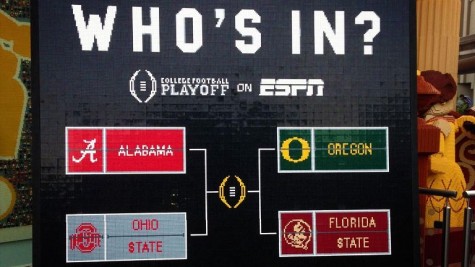New and improved?
With the release of the first ever final College Football Playoff rankings, questions still need to be answered.
On Sunday, Dec. 7, 2014, Christmas came early for college football fans across the nation. For ding-dong the witch is dead. The old, flawed Bowl Championship Series (BCS) system has finally been replaced for what has been highly anticipated: the College Football Playoff.
Four teams competing in two semifinals, the Rose Bowl and the Sugar Bowl, with the victors punching their ticket to the Promised Land — the National Championship.
Six teams were in the hunt. Week 15, the week before the final rankings were put out, the Alabama Crimson Tide was leading the pack at 11-1, with the Oregon Ducks not far behind at 11-1. They were followed by a TCU Horned Frogs team that turned lots of heads over the course of the season, and finally the Florida State Seminoles, the defending National Champion and lone undefeated team at 12-0. Florida State’s weak schedule and unconvincing wins were the only things holding them out of that top spot. On the outside looking in were the Ohio State Buckeyes and the Baylor Bears, coming in at five and six.
Then numbers one Alabama, two Oregon, four Florida State and five Ohio State all had conference championships to play the next week, with TCU and Baylor playing for a share of the Big XII title, because the Big XII doesn’t have a conference championship, preventing the conference from having one “true champion.”
Remember that for later.
On Conference Championship Weekend, Alabama, Oregon and Ohio State handily won their conferences. Florida State squeaked out another victory, which seems normal for the Seminoles at this point, and both TCU and Baylor won their final games, giving them each a share of the Big XII Championship.
Then came Sunday morning. The College Football Playoff Selection Committee now has a difficult decision on their hands. They must release their four schools to participate in the inaugural College Football Playoff.

And then there were four – The LEGO Store at Downtown Disney in Anaheim, Calif. gets in on the fun of the College Football Playoff by portraying the College Football Playoff bracket completely out of LEGO bricks.
As revealed on ESPN’s Selection Show, the top four teams to compete in the College Football Playoff are:
1. Alabama
2. Oregon
3. Florida State
4. TC–Ohio State?!
That’s right. Ohio State jumped TCU into the final four, and not only that, here are the first two out:
5. Baylor
6. TCU
Coming off a 55-3 drubbing of Iowa State, TCU did everything they could do — everything they needed to do — and they dropped three spots to number six.
There are a couple of things that could have possibly kept TCU out of the College Football Playoff. Remember that “one, true champion” spiel I was talking about earlier? How each conference has one crowned champion in a conference championship game and the Big XII does not? Well it looks like it came back to haunt both Baylor and TCU, as it kept both of them out of the big dance when one could have possibly gotten in.
Another theory is the “marketability” debate. Now this isn’t because Texas is a small football market, just ask the kids on “Friday Night Tykes.” The marketability of a “Saban-Meyer III” will draw people to the television set, possibly more than a “Saban-Patterson I.”
However I am still puzzled at the choice of Ohio State over TCU. Let’s compare the numbers.
#4 Ohio State. Final overall record of 12-1. 5-1 versus the FPI top 50. Won the Big 10 Conference Championship, defeating then 13th-ranked Wisconsin 59-0. Their one loss: at home versus unranked Virginia Tech, 35-21. Virginia Tech finished 6-6 on the season. Strength of Schedule, 45th. Strength of Record, 7th. +24 points per game differential.
#6 TCU. Final overall record of 11-1. 5-1 versus the Football Power Index (FPI) top 50. Shared the Big XII Conference Championship with Baylor. Their one loss: on the road vs. then #4 Baylor, 61-58. Baylor finished 11-1 on the season. Strength of Schedule, 53rd. Strength of Record, 4th. +26.5 points per game differential.
Don’t get me wrong, Ohio State’s numbers look great, but I don’t think that they are much better than TCU’s. They have the same number of wins and losses versus the FPI Top 50. TCU’s loss was on the road against a higher quality opponent, rather than a lesser quality opponent at home. Ohio State has a better Strength of Schedule, but TCU has a better Strength of Record, along with the highest points per game differential.
But what puts Ohio State ahead of TCU, presumably, is the 59-0 dismantling of Wisconsin in the Big 10 Championship Game. Should one game, albeit a championship game, really put the Buckeyes ahead of the Horned Frogs?
Let’s look at something numbers can’t tell you, the eye test.
Ohio State enters into the semifinals coming off of a high note in the Big 10 Championship Game, but there is a big, big question still to be answered. Can these Buckeyes continue to operate with the inexperienced, third-string quarterback Cardale Jones under center? Ever since preseason Heisman candidate Braxton Miller reinjured his shoulder, there has been a next-man-up mentality.
JT Barrett took the reins in Columbus and the Buckeyes hit the ground running, with only one bump in the road. He compiled the third best passer rating in the nation, ranked sixth in touchdown passes thrown and ninth in total offense per game. A broken ankle injury sidelined him for the rest of the season.
TCU has arguably one of the most prolific offenses in college football, as demonstrated in having the best points per game differential in the nation. Quarterback Trevon Boykin, a Heisman finalist snub, led the Frogs passing for 3,714 yards and compiling 30 touchdowns to just seven interceptions.
If you ask me, TCU should have been placed in for two reasons:
- They have a healthy quarterback. In this day and age, the value of quarterbacks has grown immensely. I will take a healthy first-stringer over an inexperienced third-stringer any day of the week and twice on Sundays.
- It would have made for a better match-up. Either team would have ended up in the number four slot, which means they draw the first ranked Alabama Crimson Tide in the Allstate Sugar Bowl Semifinal. If you ask me, TCU had a legitimate shot to keep the Tide from rolling.
Let’s go back to the Iron Bowl, Alabama-Auburn. Auburn’s duel-threat QB Nick Marshall gave the Tide fits on defense, shredding them for 44 points. However, Auburn’s defense was even worse than Alabama’s that night, as Alabama went on to win 55-44.
With TCU’s defense ranked 40 spots ahead of Auburn’s, an Alabama-TCU matchup had all the makings of an upset.
What else I don’t understand is how Baylor also jumped TCU in the final rankings. TCU had been ahead of them for the past seven weeks. Sure, Baylor owns the head-to-head tiebreaker, defeating TCU earlier in the season, but if that is the case, why weren’t they ahead of TCU for the rest of the year? Why pick now to give the Bears the jump over the Horned Frogs? Do previous rankings mean virtually nothing even though the committee says they have implications on the final rankings?
Overall, I think the committee did a fairly good job deciding the four team playoff. All in all, this is lightyears ahead of where the BCS was. If your team got snubbed, like Baylor or TCU, don’t be calling back for the BCS. Instead, call for an 8-team playoff. In fact after moving to the 4-team playoff, talks are already engaging for the possibility of an 8-team playoff next year.
Will it happen? Who knows. We’ll have to wait and see. I’d like it to happen, but unfortunately I’m not on the committee to have my voice be heard. Instead I just type them down here on my tablet for people to read.





